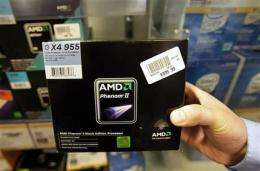A salesman holds up an Advance Micro Devices (AMD) Phenom II processor at a computer store in Santa Clara, Calif., Tuesday, July 21, 2009. Advanced Micro Devices Inc. narrowed its loss in the second quarter, even though sales at the chip company slumped 13 percent. (AP Photo/Paul Sakuma)
(AP) -- Advanced Micro Devices Inc. narrowed its loss in the second quarter, though not by as much as Wall Street hoped. Its sales slumped 13 percent.
AMD's shares plunged 12 percent in extended trading Tuesday on signs the chip company isn't being buoyed like rival Intel Corp. by the beginnings of a turnaround in the personal computer market.
AMD is the world's No. 2 maker of microprocessors, behind Intel. Microprocessors are the "brains" of PCs. Lower microprocessor prices and reliance on older technology dragged down AMD's numbers in the April-June quarter.
The chip maker's results demonstrate that the company still has some kinks to work out before it can return to profitability, a battle it's been fighting for more than two years.
Sunnyvale-based AMD is undergoing a major transformation, from a company that designs and manufactures chips into a company that only designs them - a cost-saving move. For now, though, it still reports results including its manufacturing operation, which was spun off with the help of the Abu Dhabi government. The new company is called GlobalFoundries.
AMD reported after the market closed Tuesday that the combined companies lost $330 million, or 49 cents per share, in the latest period. In the same period last year, it lost $1.2 billion, or $1.97 per share.
When a one-time gain is stripped out, AMD says it lost 62 cents per share. Analysts predicted a loss of 47 cents per share, on that same basis.
Sales fell 13 percent to $1.18 billion, not as severe a decline as expected. Analysts polled by Thomson Reuters expected revenue of $1.13 billion.
The numbers contained some troubling signs about AMD's turnaround.
One bright spot was slightly better sales of graphics chips. But falling microprocessor sales overshadowed it.
Prices have fallen for AMD's and Intel's chips. But Intel has been able to weather the fluctuations better because it has made a faster transition than AMD to new manufacturing technology, which lowers the cost of making each chip. That, in turn, helps profit margins.
AMD's margins were worrisome in the latest quarter.
AMD's gross profit margin, when GlobalFoundries' results are subtracted out, fell from 35 percent of revenue in the first quarter to 27 percent of revenue in the second. AMD executives blamed the decline in part on lower prices for its chips and the selldown of older inventory.
Gross margin is critical for chip makers because it reflects how well they're controlling their costs and prices. While AMD's gross margin is falling, Intel's is improving.
"The Street is so negative on the company, I sort of see (AMD management) not even attempting to motivate investors, in trying to drive home any sort of confidence in their prospects," said Doug Freedman, an analyst with Broadpoint.AmTech. "Some of us that follow what's happening in the supply chain are picking up that things are getting better, but it's not yet showing in AMD's numbers. So there's going to be a certain level of frustration."
Freedman said the gross margin performance "tests my enthusiasm" about AMD's prospects. "The margin performance was so weak," he said.
AMD's margins could improve as it starts selling new products and more chips built using newer equipment.
AMD shares fell 48 cents to $3.60 after the earnings report was released. The stock had closed regular trading at $4.08, down 2.2 percent on the day.
©2009 The Associated Press. All rights reserved. This material may not be published, broadcast, rewritten or redistributed.




















